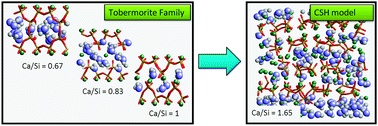Empirical force fields for complex hydrated calcio-silicate layered materials†
Abstract
The use of empirical force fields is now a standard approach in predicting the properties of hydrated

* Corresponding authors
a Department of Civil and Environmental Engineering, MIT, 77 Massachusetts Av., Cambridge, USA
b Centre Interdisciplinaire des Nanosciences de Marseille, CNRS and Marseille Université, Campus de Luminy, Marseille, cedex 09, France
The use of empirical force fields is now a standard approach in predicting the properties of hydrated

 Please wait while we load your content...
Something went wrong. Try again?
Please wait while we load your content...
Something went wrong. Try again?
R. Shahsavari, R. J.-M. Pellenq and F. Ulm, Phys. Chem. Chem. Phys., 2011, 13, 1002 DOI: 10.1039/C0CP00516A
To request permission to reproduce material from this article, please go to the Copyright Clearance Center request page.
If you are an author contributing to an RSC publication, you do not need to request permission provided correct acknowledgement is given.
If you are the author of this article, you do not need to request permission to reproduce figures and diagrams provided correct acknowledgement is given. If you want to reproduce the whole article in a third-party publication (excluding your thesis/dissertation for which permission is not required) please go to the Copyright Clearance Center request page.
Read more about how to correctly acknowledge RSC content.
 Fetching data from CrossRef.
Fetching data from CrossRef.
This may take some time to load.
Loading related content
